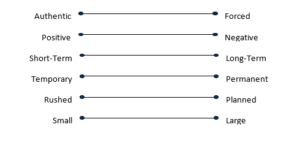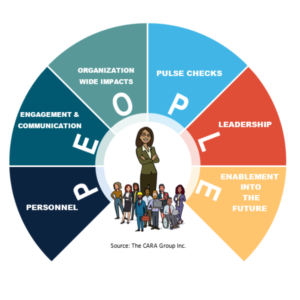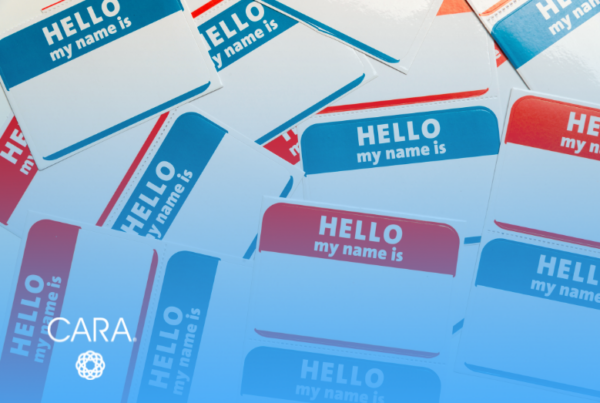
Take a moment and count all the small (and large) changes that have occurred in your lifetime, in the last day, even the last hour. Have you lost count? Personally, in the last couple of months, I have become a wife, moved to a new ERP platform at work, got a new email address (crazy how big this can impact someone and the people around them!), downloaded a few new phone apps that changed my home screen, as well as countless other new circumstances that keep life interesting.
“The “PEOPLE” tool can be a go-to way to explain change management or introduce change concepts into the many areas where you encounter change in your daily life.”
As you can visualize with the changes I briefly mentioned, not all change is created equal and how we handle that change varies. That holds true in business as well – not all change is the same and, therefore, can be governed differently based on the circumstances. Change can scale on several different factors – below are a few examples:

Change Management Strategy or Basic Change Concepts?
Since not every change is the same, not every change requires the same level of intervention to gain adoption or behavior change. So, how do you know when you need to develop a full change management strategy and plan versus utilizing basic change concepts and tools? When answering this, here are a few helpful questions to consider:
- How complex are the changes that people will need to understand?
- How large is the change effort? Are there multiple goals that require changes happening at once?
- How many other initiatives or changes are occurring simultaneously?
- Will the change(s) and behavior be more a push or a pull to gain buy-in? Will this likely be viewed as a positive or negative experience?
- How many individuals will be impacted by the change?
- How aligned are leaders to the change that is taking place?
Based on your responses, if you find your change is large, complex, will encounter a lot of resistance or other factors that may warrant a true change plan, consider involving a professional change practitioner.
If the change doesn’t require a full change management strategy and plan, is there a simplified way to explain and leverage change management principles for these smaller, everyday changes? How can change practitioners help others easily adopt a change management mindset?
Introducing the PEOPLE Tool
CARA’s “PEOPLE” tool is intended just for that purpose – a tool to untangle the complicated change management methodologies and tools. If you consider each element of the “PEOPLE” framework, you can better manage change (even as a non-change practitioner).

- P – Personnel: Who is impacted by the change both directly and indirectly?
- E – Engagement and Communication: Who needs to be told “what” and when? How?
- O – Organization Wide Impact: In what ways will things change for people? What are the behaviors and ways of working that need to adjust to ensure success?
- P – Pulse Checks: How are we evaluating readiness and attitudes towards the change?
- L- Leadership: Are leaders aligned to the change that is occurring and what it means for their employees?
- E – Enablement into the Future: How are we upskilling and providing reinforcements to sustain the change(s)?
Using the “PEOPLE” Tool
In recent discussions I have had with clients, this tool has become incredibly useful in explaining the “how” behind change management without using jargon such as “stakeholder analysis” or “change impact assessments”. For example, organizations can use the tool to upskill their non-change employees as a first step in creating a culture of change and transformation.
The “PEOPLE” tool is not intended to be used as a replacement for seasoned change practitioners. Instead, it is a tool for those who want to incorporate change management principles into their everyday knowledge and routines and discuss change management in simplified terms.
Three practical uses include:
- Upskilling non-change practitioners on change management techniques and ways of thinking
- Incorporating an easy tool for leaders and managers in an organization to bring change in everyday thinking
- “Selling Change” to the non-believer
Whether you are new to change management principles or have been using these concepts for years, it is clear that change is constant, and people need to be agile. With that, not all changes are equal and, therefore, do not need to be managed the same. The “PEOPLE” tool can be a go-to way to explain change management or introduce change concepts into the many areas where you encounter change in your daily life.
How do you address varying scales of change? How would you use this tool?
If you want to learn more about this tool, how to educate your organization in change principles, or how to assess where your change priorities scale, contact The CARA Group for more information at marketing@thecaragroup.com.



